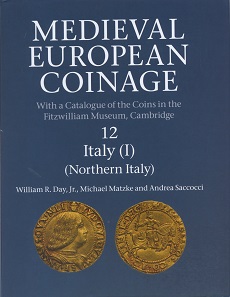by Ursula Kampmann
translated by Annika Backe
June 22, 2017 – The Coin Cabinet of the Fitzwilliam Museum in Cambridge is responsible for a huge project that makes the RIC – known to every collector of Roman coins – look like a pretty, small and neatly arranged catalog for beginners. Ranging from the early to the late Middle Ages, all European coins are published in the volumes of the MEC (= Medieval European Coinage). A mammoth task if you think of all the smaller and smallest mints of this era! No wonder that only five of the planned 20 volumes have been published in the last 30 years! Recently, Volume 12 as the fourth catalog has been released, considering the coins of Northern Italy. (By the way, Volume 8 – Britain and Ireland c. 400 and 1066 – has been published in April 2017; we have asked for a review copy.)
The authors responsible for Northern Italy are William R. Day, former Research Associate at the Coin Cabinet of the Fitzwilliam Museum (Liguria, Piedmont as well as the introduction and the appendices), Michael Matzke, Curator at the Coin Cabinet of the Basel Historical Museum, (1st draft and Lombardy – except for Mantua), and Andrea Saccocci, Professor in Numismatics at the University of Udine (Veneto and Mantua).
William R. Day Jr., Michael Matzke, Andrea Saccocci, Medieval European Coinage with a Catalogue of the Coins in the Fitzwilliam Museum, Cambridge. Vol. 12: Italy (I) (Northern Italy). Cambridge University Press, Cambridge 2016. 1135 pages with 80 plates as well as b/w illustrations and maps, 25.3 x 19.7 cm. Hardcover. ISBN: 978-0-521-26021-3. GBP 175.
To sum up: With its 831 pages and 80 plates, the latest MEC volume constitutes a comprehensive handbook. However, it takes a great deal of expert knowledge to access it, for the plates are a challenge to the eyes. They illustrate the specimens of the vast collection the basis of which has been assembled by Professor Philipp Grierson who then gave it to the Fitzwilliam Museum. The non-expert in medieval coinage is impressed by the collection being so rich; though he or she immediately wishes for some clear drawings of the coins (or at least for photos with a higher contrast that go beyond the uniform colors in shades of grey. This would make it much easier to identify the strikings. Anyone thinking that flipping through the pages might be enough to find the relevant mint will be proven mistaken in this case. Little crosses, heads and letters simply don’t provide sufficient clues to identify a coin on the basis of the image alone. What it takes is that you can read the specimen’s inscription. Only through the legend can you easily find the relevant illustration of the coin in the text, and afterwards get to the comment and the academic annotations.
The wealth of information provided in this book is impressive to see. It is arranged in a chronological order first, then according to currency areas, starting with the royal and the imperial strikings from the Ottonian revival onwards, to the early stages of municipal coinage. In a geographical order, arranged according to the regions – Piedmont, Liguria, Lombardy (including Bellinzona), and Veneto (including Friuli and Southern Tyrol) –, the coins of the varying minting authorities are presented. In practical terms, this means that the authors have documented the strikings produced by 55(!) minting authorities – and that doesn’t even include the royal-imperial coinage. Among them are such major trading cities as Genoa (50 pages), Milan (102 pages), and Venice (26 pages).
The volume is opened by a general introduction to the historical background and the coinage of Northern Italy. Showing the silver mines in operation at the time and the passes accessed, a map illustrates where the metal for the coinages came from and which routes were taken. You can find information on the right to mint coins, on denomination systems, on motifs, legends and circulation areas.
Each of the following chapters commence with another introduction. It combines the historical background and the literature before the coinage is itemized in detail on the basis of the most recent literature. In these chapters you find some of the drawings you sorely missed in the plates.
What more is there to write? It’s abundantly clear that the MEC is a must-have for every self-respecting numismatic library. To the coin enthusiast, it’s an indispensable tool for identification which renders countless other books obsolete. To the collector, it’s an abundant source of information in English in a field that sees the most important works – except for South Tyrol – being written in Italian. And it hardly needs mentioning that the researcher gladly accesses the MEC if he or she wants to quickly get a synopsis of the current state of research.
The MEC, though, is also absolutely essential for all those who are occupied with the general history and the economic history of Europe. Northern Italy being particularly important in this regard, this book should become part not just in numismatic but also in historical libraries.
You can order the MEC at the Cambridge University Press website.
We can only recommend visiting the mentioned webpage for it also gives you the chance to order all the other volumes some of which have already been published as a reprint.
Additional information on the project as a whole can be obtained from this site of the Coin Cabinet of the Fitzwilliam Museum.
And the Cambridge Coin Cabinet is at the center of an in-depth article at CoinsWeekly.





